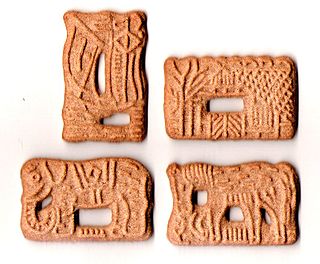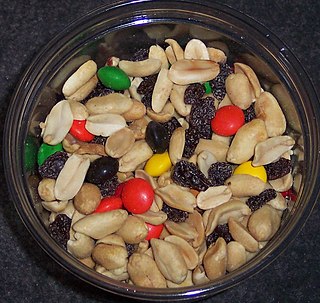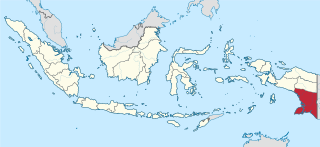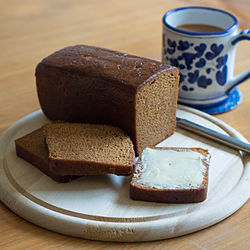
Satay, or sate in Indonesian spelling, is a Southeast Asian dish of seasoned, skewered and grilled meat, served with a sauce. The earliest preparations of satay is believed to have originated in Java island, but has spread to almost anywhere in Indonesia, where it has become a national dish. Indonesian satay is often served with peanut sauce – a sauce made from ground roasted peanuts, and is often accompanied with lontong, a type of rice cake, though the diversity of the country has produced a wide variety of satay recipes. It is also popular in many other Southeast Asian countries including Brunei, Malaysia, Philippines, Singapore and Thailand. It is also recognized and popular in Suriname and the Netherlands. In Sri Lanka, it has become a staple of the local diet as a result of the influences from the local Malay community.

Nasi lemak is a dish originating in Malay cuisine that consists of fragrant rice cooked in coconut milk and pandan leaf. It is commonly found in many countries in Southeast Asia, most prominently in the Malay Archipelago or the "Nusantara" regions with significant Malay populations such as Brunei, Indonesia, Malaysia, Singapore, and Southern Thailand. In Indonesia it can be found in several parts of Sumatra, especially the Malay regions of Riau, Riau Islands and Medan. Nasi lemak can also be found in the Bangsamoro region of Mindanao, prepared by Filipino Moros, as well as Australia's external territories of Christmas Island and the Cocos (Keeling) Islands. It is considered an essential dish for a typical Malay-style breakfast.

Indonesian cuisine is a collection of various regional culinary traditions that formed the archipelagic nation of Indonesia. There are a wide variety of recipes and cuisines in part because Indonesia is composed of approximately 6,000 populated islands of the total 17,508 in the world's largest archipelago, with more than 1,300 ethnic groups.

Rendang is a Minangkabau dish. It is a rich dish of meat that has been slow cooked and braised in a coconut milk seasoned with a herb and spice mixture over a period of several hours until the liquids evaporate and the meat turns dark brown and tender, becoming caramelized and infused with rich flavours.
Dutch cuisine is formed from the cooking traditions and practices of the Netherlands. The country's cuisine is shaped by its location in the fertile North Sea river delta of the European Plain, giving rise to fishing, farming and overseas trade. The Burgundian-Habsburg court enriched the cuisine of the Dutch elite in the 15th and 16th century, so did the colonial spice trade in the 17th century.

Speculaas is a type of spiced shortcrust biscuit baked with speculaas spices.

Otak-otak is a Southeast Asian fish cake made of ground fish mixed with spices and wrapped in leaf parcels. Otak-otak is traditionally served steamed or grilled, encased within the leaf parcel it is cooked in, and can be eaten solely as a snack or with steamed rice as part of a meal.

Nasi goreng is a Southeast Asian fried rice dish, usually cooked with pieces of meat and vegetables. One of Indonesia's national dishes, it is also eaten in Malay-speaking communities in countries such as Malaysia, Singapore and Brunei, and has gained popularity in Sri Lanka through migrations from the Malay Archipelago, in countries like Suriname via Indonesian immigrant communities, and in the Netherlands through its colonial ties with Indonesia. Nasi goreng is distinguished from other Asian fried rice preparations by its distinct smoky aroma, and caramelised yet savoury undertones of flavour. There is no single defined recipe for nasi goreng, and its composition and preparation varies greatly from household to household.

Pecel is a traditional Javanese salad with peanut sauce, usually eaten with carbs.

Spekkoek is a type of Indonesian layer cake. It was developed during colonial times in the Dutch East Indies. The firm-textured cake is an Indo (Dutch-Indonesian) version of the European multi-layered spit cake. However it is not baked on a rotating spit, and contains a mix of Indonesian spices, such as cardamom, cinnamon, clove, mace and anise. The cake is made of flour and yolk and is rich in butter or margarine.

Lontong is an Indonesian dish made of compressed rice cake in the form of a cylinder wrapped inside a banana leaf, commonly found in Indonesia, Malaysia and Singapore. Rice is rolled inside a banana leaf and boiled, then cut into small cakes as a staple food replacement of steamed rice. The texture is similar to those of ketupat, with the difference being that the ketupat container is made from woven janur fronds, while lontong uses banana leaf instead.

Toast is sliced bread that has been browned by radiant heat. The browning is the result of a Maillard reaction altering the flavor of the bread and making it firmer. The firm surface is easier to spread toppings on and the warmth can help butter reach its melting point. Toasting is a common method of making stale bread more palatable. Bread is toasted using a toaster or a toaster oven. Toast may contain acrylamide caused by the browning process, which is suspected to be a carcinogen. However, claims that acrylamide in burnt toast causes cancer have not been proven.

Ayam penyet is Indonesian — more precisely East Javanese cuisine — fried chicken dish consisting of fried chicken that is squeezed with the pestle against the mortar to make it softer, and is served with sambal, slices of cucumbers, fried tofu, and tempeh. In Indonesia, penyet dishes such as fried chicken and ribs are commonly associated with Surabaya, the capital city of East Java. The most popular ayam penyet variant is ayam penyet Suroboyo.

Kaasstengels, Kastengel or kue keju are a Dutch cheese snack in the shape of sticks. Owed to its colonial links to the Netherlands, kaasstengels are also commonly found in Indonesia. The name refers to its ingredients, shape and origin; kaas is the Dutch word for "cheese", while stengels means "sticks". Unlike most cookies, kaasstengels taste savoury and salty instead of sweet.

Soto is a traditional Indonesian soup mainly composed of broth, meat, and vegetables. Many traditional soups are called soto, whereas foreign and Western influenced soups are called sop.

A snack is a small portion of food generally eaten between meals. Snacks come in a variety of forms including packaged snack foods and other processed foods, as well as items made from fresh ingredients at home.

South Papua, officially the South Papua Province, is an Indonesian province located in the southern portion of Papua, following the borders of Papuan customary region of Anim Ha. Formally established on 11 November 2022 and including the four most southern regencies that were previously part of the province of Papua and before 11 December 2002 were all part of a larger Merauke Regency, it covers an area of 117,849.16 km2. It had a population of 522,215 according to the official estimates for mid 2022, making it the least populous province in Indonesia.

Kue lidah kucing is a small Indonesian biscuit shaped somewhat like a cat's tongue. They are sweet and crunchy. This cookie is a Dutch-influenced cookie due to the historical tie between Indonesia and the Netherlands. In the Netherlands, this cookie is known as kattentong, and ultimately derived from European cat tongue biscuit.

Indian Indonesian cuisine is characterized by the mixture of Indian cuisine with local Indonesian-style. This cuisine consists of adaptations of authentic dishes from India, as well as original creations inspired by the diverse food culture of Indonesia. Indian influence can be observed in Indonesia as early as the 4th century. Following the spread of Islam to Indonesia and trading, Muslim Indian as well as Arab influences made their way into Indonesian cuisine. Examples include Indian biryani, murtabak, curry and paratha that influenced Acehnese, Minangkabau, Malay, Palembangese, Betawi and Javanese cuisine.

Geprek Bensu is an Indonesia-based fast food restaurant chain primarily serving ayam geprek. As of December 2018, the chain had 110 franchises in Indonesia, employing an estimated 3,500 people. The chain also operates in Hong Kong and Malaysia, and plans to expand to Taiwan and the Netherlands.



















